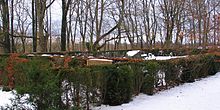grove

A grove , and wood and wood called, is a small forest .
Word origin and meaning

The word grove originated in the 14th century from Middle High German hagen for "cherished forest", as a variant of hag (cf. hornbeam , hagebeam) and is considered to be out of date in this meaning today. Today it is primarily used in the sense of “grove, group of trees”, i.e. for a small forest or a wood.
Martin Luther (1483–1546) and later were particularly responsible for the development and expansion of the term grove to a "cherished and pacified forest in which a deity is worshiped" ("holy grove") and to agricultural areas ("vine grove") Friedrich Gottlieb Klopstock (1724–1803) responsible. In addition, grove can be found in the meaning of "Lustwald" and " Park ", as well as a word component in additions such as Friedenshain and Totenhain , with which forest cemeteries are meant.
Luther used Hain in his translation of the Bible into German. Christoph Martin Wieland and Klopstock took up the floor again. In Klopstock's imagination, the grove was the seat and symbol of Germanic poetry. Under his influence, Johann Heinrich Voss and his poet friends founded a poet association in Göttingen in 1772 under the name Hain , which was renamed Hainbund in 1804 . The “grove” then became a general literary topos . Goethe's Iphigenie auf Tauris from 1786 begins with the lines: Out into your shadows, lively treetops / Of the old, holy, leafy grove .
Place and field names
Hain can be found - just like Hag - as part of the name in many German-speaking place names, for example Hainburg , Haindorf , Hainfeld and Hannover-Hainholz , or Belgershain , Berlin-Friedrichshain , Dreieichenhain , Hirzenhain and Ziegenhain , or as Hainleite and Hainich , two ridges in northwestern Thuringia .
"Groves" in ancient times
Numerous ancient references to sacred wooded areas were translated into German with the word “grove” and in turn enriched the term with sacred and poetic connotations .
Ancient Israel
Abraham settled in the Holy Land (Genesis 13, 18, in Luther's original version from 1545): “So Abram raised his tents | came and wonet in the Hayn Mamre | that is to Hebron | And bawet there an altar to the Lord . "
Greeks and Romans
The Greeks chose a piece of forest and consecrated it to a deity, to whom altars, temples and statues were soon erected. Terms that are in English have been since the humanism of the oak grove of Dodona , the sacred grove (the Altis ) to Olympia , the Eumenides grove at Colonus near Athens and the grove of Artemis at Ephesus .
The word “grove” also prevailed in German for the lucus (or nemus ) of the Romans, for the grove of Egeria near Aricia , that of the furies near Rome and the grove of muses in Latium .
Germanic peoples
In a similar way, one encounters the veneration of sacred forests and trees among the Germanic peoples (cf. tree cult , Irminsul ; among the trees, the ash was primarily considered to be sacred, cf. Yggdrasil , then the linden , also elm , oak or fir ). The existence of the custom for the pre-Christian time is already mentioned by Tacitus , and it is also often confirmed, so Arminius arranged his troops in a grove, and in such a grove Civilis also gathered his Batavians for feasting and deliberation. Anyone who was persecuted and escaped into a sacred grove (or reached the shade of a sacred tree) was inviolable. With the blossoming of old German studies , the term “grove” was also chosen here for the corresponding terms of the mostly Latin written sources.
See also
Web links
Individual evidence
- ↑ Kluge: Etymological Dictionary of the German Language , 24th edition, 2002.
- ↑ Mackensen: Large German Dictionary , 1977.
- ↑ Cf. references in the German dictionary by Jacob Grimm and Wilhelm Grimm , 16 vols. [In 32 partial volumes]. S. Hirzel, Leipzig 1854-1960. In the Kluge (2002) and in the Etymologie-Duden (1989) only Klopstock's importance is emphasized.
- ↑ See references in the German dictionary by Jacob Grimm and Wilhelm Grimm , 16 vols. [In 32 partial volumes], S. Hirzel, Leipzig 1854–1960. The “Friedenshain” is also individually lemmatized there.
- ↑ Duden Etymology. Dictionary of origin of the German language , Dudenverlag, 1989.
- ^ Edition Hans Volz , dtv, Munich 1974, ISBN 3-423-06031-X .
- ↑ Cf. Oedipus on Colonus of Sophocles .
- ↑ On Corinth cf. Friedrich Schiller , Die Kraniche des Ibykus : "And in Poseidon's Fichtenhain / He enters with a pious shudder."


